Economic Assignment: Microeconomic Analysis of Quinoa, Acai, and Chia
VerifiedAdded on 2020/03/16
|8
|2010
|161
Report
AI Summary
This report provides a microeconomic evaluation of an article focusing on the rising popularity and market dynamics of superfoods like quinoa, acai, and chia. It analyzes the forces of demand and supply, highlighting how the increasing global demand for these nutrient-rich foods has impacted prices and trade. The report examines the role of elasticity of demand, noting the inelastic nature of demand for traditional staples versus the elastic demand observed for superfoods. It explores the impact of supply constraints, particularly for quinoa, and how increased production, often through expanding cultivation areas, has affected market equilibrium and price stabilization. Furthermore, the report discusses the relationship between quinoa prices and household welfare, suggesting that, contrary to some concerns, rising prices may correlate with improved economic well-being in certain regions. The analysis concludes by summarizing the key microeconomic principles illustrated by the superfood market trends, emphasizing the interplay of supply, demand, and elasticity in shaping price and consumer behavior.
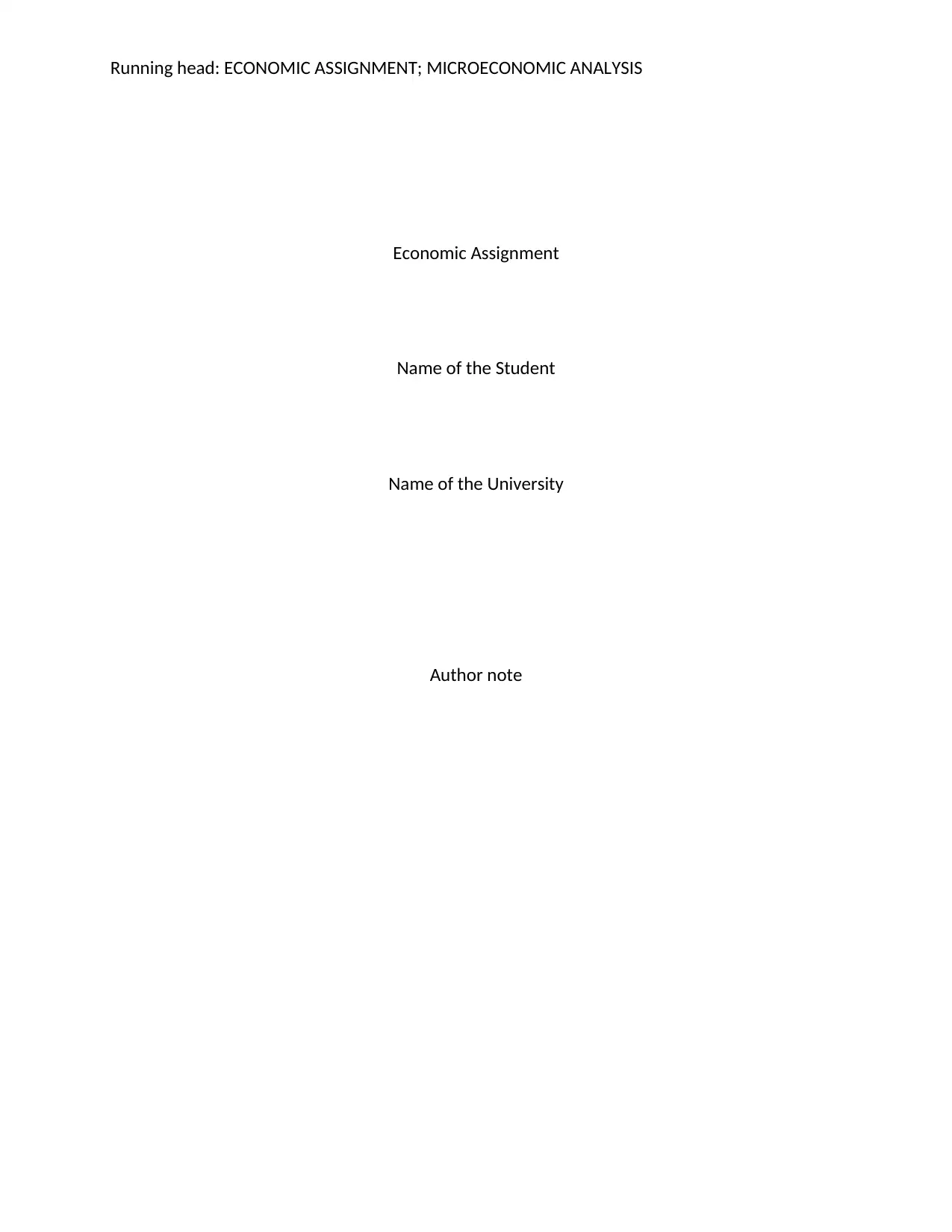
Running head: ECONOMIC ASSIGNMENT; MICROECONOMIC ANALYSIS
Economic Assignment
Name of the Student
Name of the University
Author note
Economic Assignment
Name of the Student
Name of the University
Author note
Paraphrase This Document
Need a fresh take? Get an instant paraphrase of this document with our AI Paraphraser
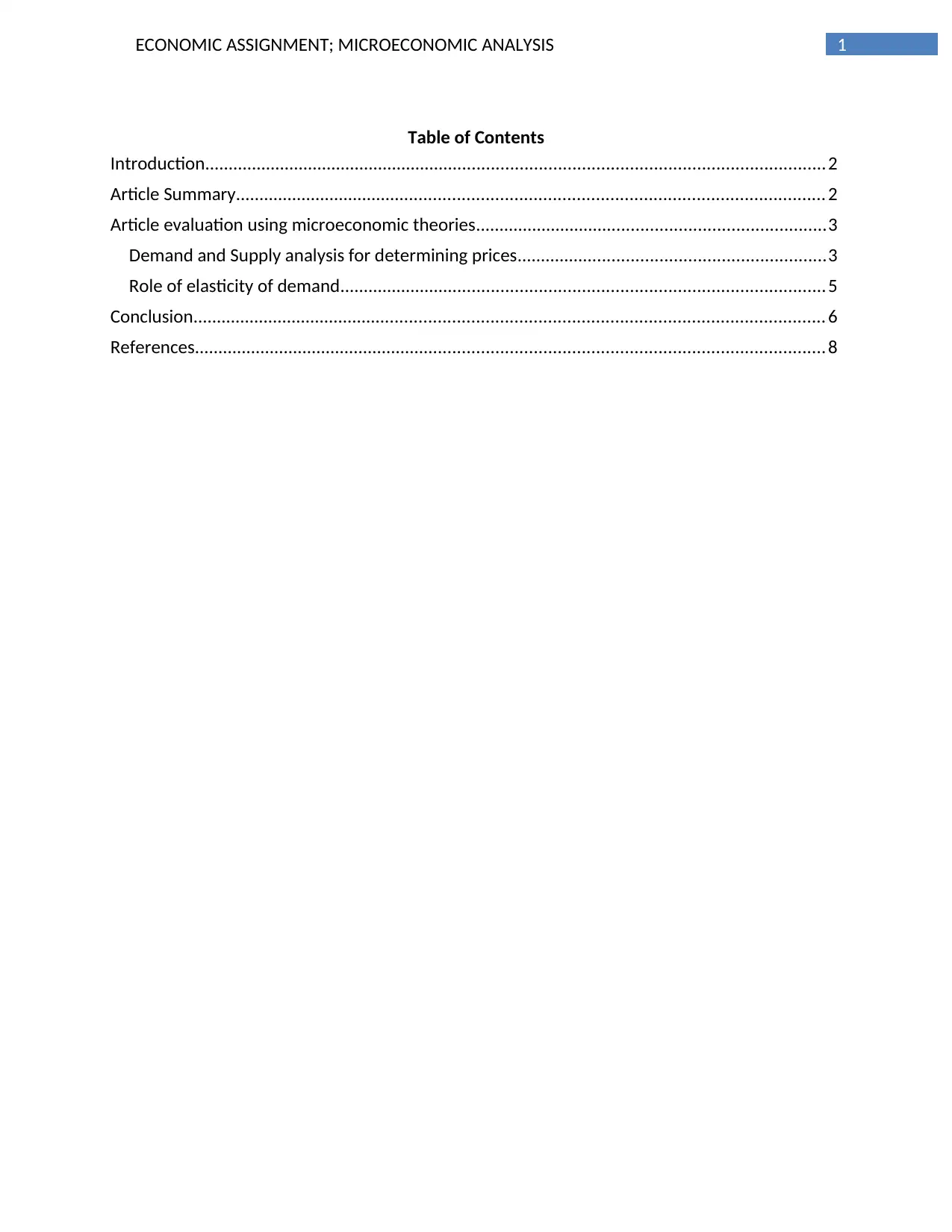
1ECONOMIC ASSIGNMENT; MICROECONOMIC ANALYSIS
Table of Contents
Introduction...................................................................................................................................2
Article Summary............................................................................................................................ 2
Article evaluation using microeconomic theories..........................................................................3
Demand and Supply analysis for determining prices.................................................................3
Role of elasticity of demand......................................................................................................5
Conclusion..................................................................................................................................... 6
References..................................................................................................................................... 8
Table of Contents
Introduction...................................................................................................................................2
Article Summary............................................................................................................................ 2
Article evaluation using microeconomic theories..........................................................................3
Demand and Supply analysis for determining prices.................................................................3
Role of elasticity of demand......................................................................................................5
Conclusion..................................................................................................................................... 6
References..................................................................................................................................... 8
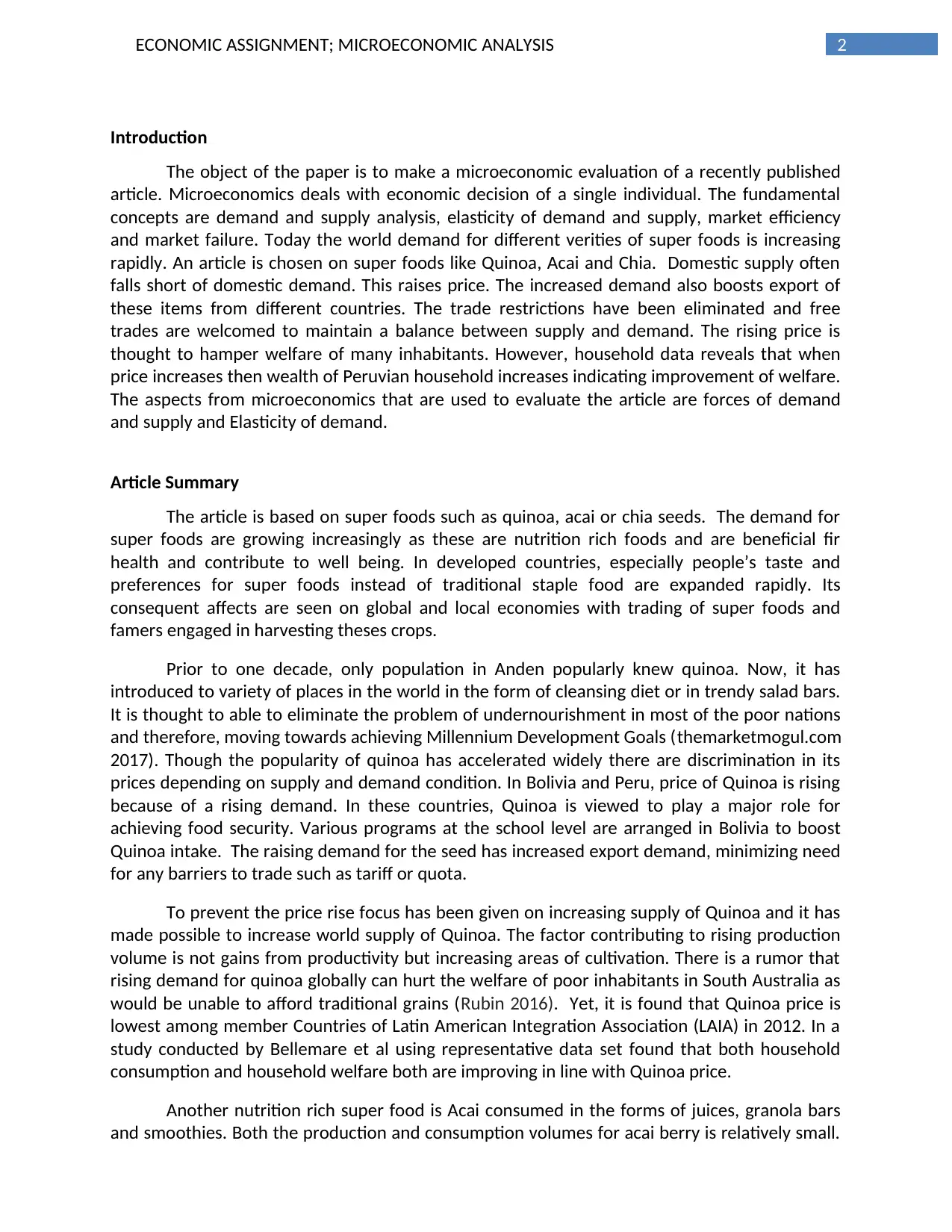
2ECONOMIC ASSIGNMENT; MICROECONOMIC ANALYSIS
Introduction
The object of the paper is to make a microeconomic evaluation of a recently published
article. Microeconomics deals with economic decision of a single individual. The fundamental
concepts are demand and supply analysis, elasticity of demand and supply, market efficiency
and market failure. Today the world demand for different verities of super foods is increasing
rapidly. An article is chosen on super foods like Quinoa, Acai and Chia. Domestic supply often
falls short of domestic demand. This raises price. The increased demand also boosts export of
these items from different countries. The trade restrictions have been eliminated and free
trades are welcomed to maintain a balance between supply and demand. The rising price is
thought to hamper welfare of many inhabitants. However, household data reveals that when
price increases then wealth of Peruvian household increases indicating improvement of welfare.
The aspects from microeconomics that are used to evaluate the article are forces of demand
and supply and Elasticity of demand.
Article Summary
The article is based on super foods such as quinoa, acai or chia seeds. The demand for
super foods are growing increasingly as these are nutrition rich foods and are beneficial fir
health and contribute to well being. In developed countries, especially people’s taste and
preferences for super foods instead of traditional staple food are expanded rapidly. Its
consequent affects are seen on global and local economies with trading of super foods and
famers engaged in harvesting theses crops.
Prior to one decade, only population in Anden popularly knew quinoa. Now, it has
introduced to variety of places in the world in the form of cleansing diet or in trendy salad bars.
It is thought to able to eliminate the problem of undernourishment in most of the poor nations
and therefore, moving towards achieving Millennium Development Goals (themarketmogul.com
2017). Though the popularity of quinoa has accelerated widely there are discrimination in its
prices depending on supply and demand condition. In Bolivia and Peru, price of Quinoa is rising
because of a rising demand. In these countries, Quinoa is viewed to play a major role for
achieving food security. Various programs at the school level are arranged in Bolivia to boost
Quinoa intake. The raising demand for the seed has increased export demand, minimizing need
for any barriers to trade such as tariff or quota.
To prevent the price rise focus has been given on increasing supply of Quinoa and it has
made possible to increase world supply of Quinoa. The factor contributing to rising production
volume is not gains from productivity but increasing areas of cultivation. There is a rumor that
rising demand for quinoa globally can hurt the welfare of poor inhabitants in South Australia as
would be unable to afford traditional grains (Rubin 2016). Yet, it is found that Quinoa price is
lowest among member Countries of Latin American Integration Association (LAIA) in 2012. In a
study conducted by Bellemare et al using representative data set found that both household
consumption and household welfare both are improving in line with Quinoa price.
Another nutrition rich super food is Acai consumed in the forms of juices, granola bars
and smoothies. Both the production and consumption volumes for acai berry is relatively small.
Introduction
The object of the paper is to make a microeconomic evaluation of a recently published
article. Microeconomics deals with economic decision of a single individual. The fundamental
concepts are demand and supply analysis, elasticity of demand and supply, market efficiency
and market failure. Today the world demand for different verities of super foods is increasing
rapidly. An article is chosen on super foods like Quinoa, Acai and Chia. Domestic supply often
falls short of domestic demand. This raises price. The increased demand also boosts export of
these items from different countries. The trade restrictions have been eliminated and free
trades are welcomed to maintain a balance between supply and demand. The rising price is
thought to hamper welfare of many inhabitants. However, household data reveals that when
price increases then wealth of Peruvian household increases indicating improvement of welfare.
The aspects from microeconomics that are used to evaluate the article are forces of demand
and supply and Elasticity of demand.
Article Summary
The article is based on super foods such as quinoa, acai or chia seeds. The demand for
super foods are growing increasingly as these are nutrition rich foods and are beneficial fir
health and contribute to well being. In developed countries, especially people’s taste and
preferences for super foods instead of traditional staple food are expanded rapidly. Its
consequent affects are seen on global and local economies with trading of super foods and
famers engaged in harvesting theses crops.
Prior to one decade, only population in Anden popularly knew quinoa. Now, it has
introduced to variety of places in the world in the form of cleansing diet or in trendy salad bars.
It is thought to able to eliminate the problem of undernourishment in most of the poor nations
and therefore, moving towards achieving Millennium Development Goals (themarketmogul.com
2017). Though the popularity of quinoa has accelerated widely there are discrimination in its
prices depending on supply and demand condition. In Bolivia and Peru, price of Quinoa is rising
because of a rising demand. In these countries, Quinoa is viewed to play a major role for
achieving food security. Various programs at the school level are arranged in Bolivia to boost
Quinoa intake. The raising demand for the seed has increased export demand, minimizing need
for any barriers to trade such as tariff or quota.
To prevent the price rise focus has been given on increasing supply of Quinoa and it has
made possible to increase world supply of Quinoa. The factor contributing to rising production
volume is not gains from productivity but increasing areas of cultivation. There is a rumor that
rising demand for quinoa globally can hurt the welfare of poor inhabitants in South Australia as
would be unable to afford traditional grains (Rubin 2016). Yet, it is found that Quinoa price is
lowest among member Countries of Latin American Integration Association (LAIA) in 2012. In a
study conducted by Bellemare et al using representative data set found that both household
consumption and household welfare both are improving in line with Quinoa price.
Another nutrition rich super food is Acai consumed in the forms of juices, granola bars
and smoothies. Both the production and consumption volumes for acai berry is relatively small.
⊘ This is a preview!⊘
Do you want full access?
Subscribe today to unlock all pages.

Trusted by 1+ million students worldwide
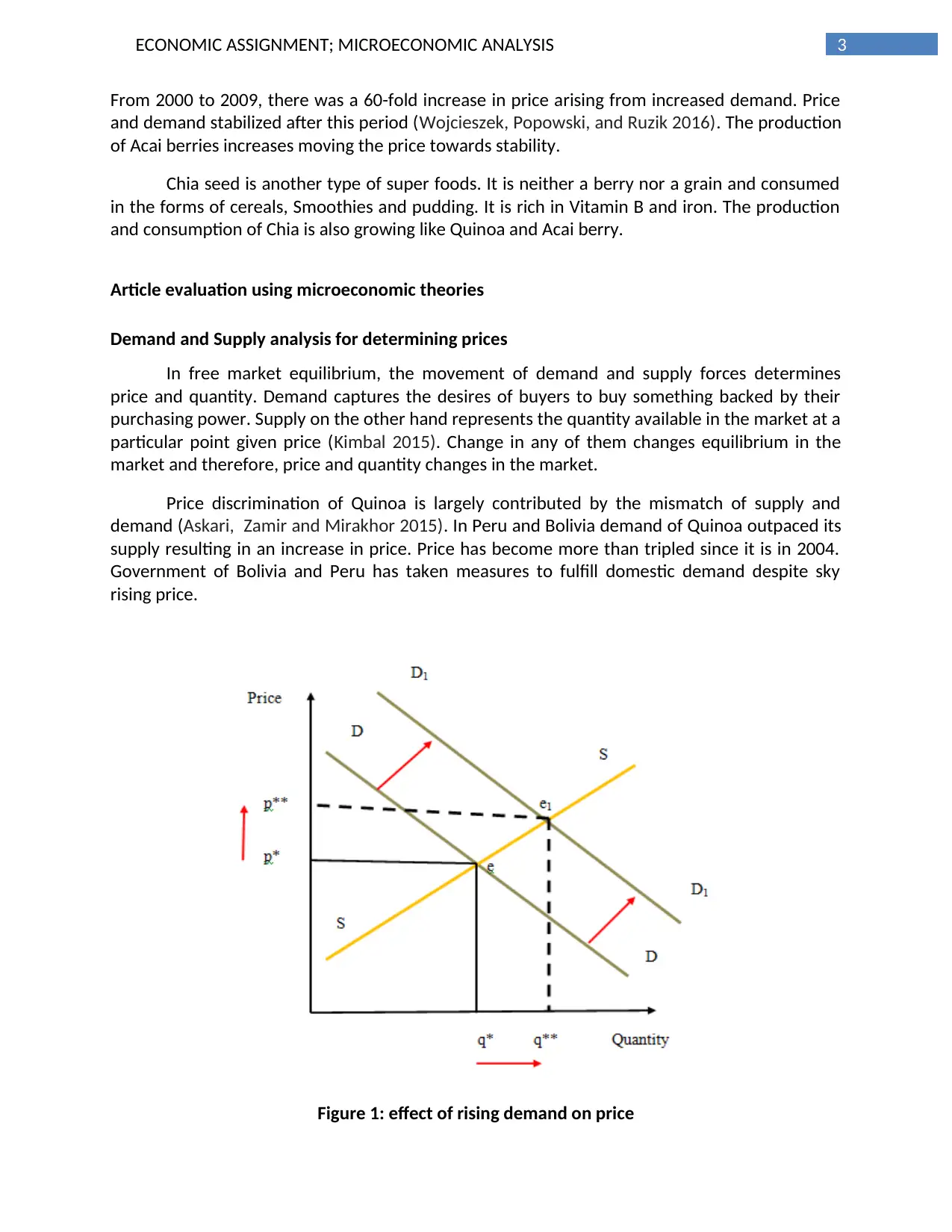
3ECONOMIC ASSIGNMENT; MICROECONOMIC ANALYSIS
From 2000 to 2009, there was a 60-fold increase in price arising from increased demand. Price
and demand stabilized after this period (Wojcieszek, Popowski, and Ruzik 2016). The production
of Acai berries increases moving the price towards stability.
Chia seed is another type of super foods. It is neither a berry nor a grain and consumed
in the forms of cereals, Smoothies and pudding. It is rich in Vitamin B and iron. The production
and consumption of Chia is also growing like Quinoa and Acai berry.
Article evaluation using microeconomic theories
Demand and Supply analysis for determining prices
In free market equilibrium, the movement of demand and supply forces determines
price and quantity. Demand captures the desires of buyers to buy something backed by their
purchasing power. Supply on the other hand represents the quantity available in the market at a
particular point given price (Kimbal 2015). Change in any of them changes equilibrium in the
market and therefore, price and quantity changes in the market.
Price discrimination of Quinoa is largely contributed by the mismatch of supply and
demand (Askari, Zamir and Mirakhor 2015). In Peru and Bolivia demand of Quinoa outpaced its
supply resulting in an increase in price. Price has become more than tripled since it is in 2004.
Government of Bolivia and Peru has taken measures to fulfill domestic demand despite sky
rising price.
Figure 1: effect of rising demand on price
From 2000 to 2009, there was a 60-fold increase in price arising from increased demand. Price
and demand stabilized after this period (Wojcieszek, Popowski, and Ruzik 2016). The production
of Acai berries increases moving the price towards stability.
Chia seed is another type of super foods. It is neither a berry nor a grain and consumed
in the forms of cereals, Smoothies and pudding. It is rich in Vitamin B and iron. The production
and consumption of Chia is also growing like Quinoa and Acai berry.
Article evaluation using microeconomic theories
Demand and Supply analysis for determining prices
In free market equilibrium, the movement of demand and supply forces determines
price and quantity. Demand captures the desires of buyers to buy something backed by their
purchasing power. Supply on the other hand represents the quantity available in the market at a
particular point given price (Kimbal 2015). Change in any of them changes equilibrium in the
market and therefore, price and quantity changes in the market.
Price discrimination of Quinoa is largely contributed by the mismatch of supply and
demand (Askari, Zamir and Mirakhor 2015). In Peru and Bolivia demand of Quinoa outpaced its
supply resulting in an increase in price. Price has become more than tripled since it is in 2004.
Government of Bolivia and Peru has taken measures to fulfill domestic demand despite sky
rising price.
Figure 1: effect of rising demand on price
Paraphrase This Document
Need a fresh take? Get an instant paraphrase of this document with our AI Paraphraser
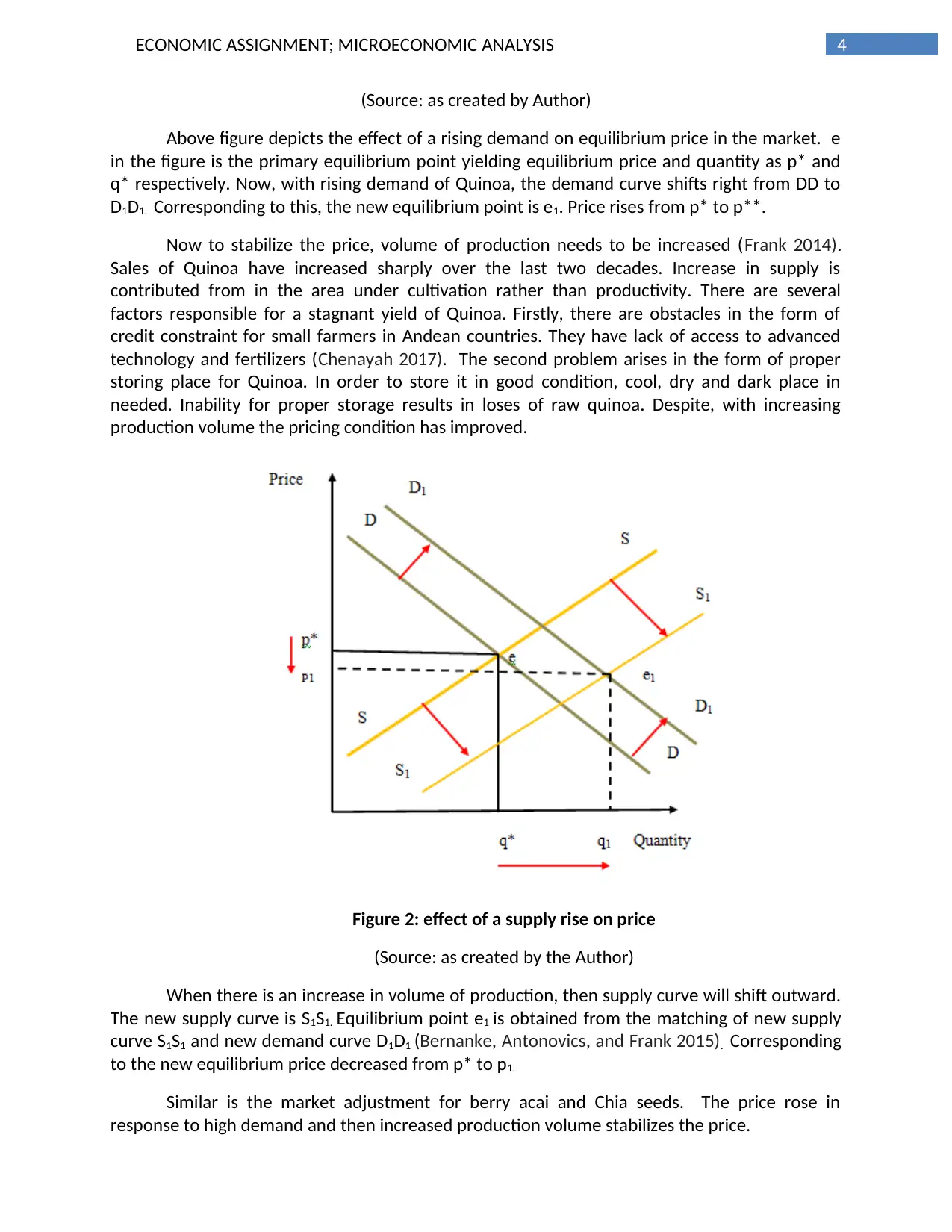
4ECONOMIC ASSIGNMENT; MICROECONOMIC ANALYSIS
(Source: as created by Author)
Above figure depicts the effect of a rising demand on equilibrium price in the market. e
in the figure is the primary equilibrium point yielding equilibrium price and quantity as p* and
q* respectively. Now, with rising demand of Quinoa, the demand curve shifts right from DD to
D1D1. Corresponding to this, the new equilibrium point is e1. Price rises from p* to p**.
Now to stabilize the price, volume of production needs to be increased (Frank 2014).
Sales of Quinoa have increased sharply over the last two decades. Increase in supply is
contributed from in the area under cultivation rather than productivity. There are several
factors responsible for a stagnant yield of Quinoa. Firstly, there are obstacles in the form of
credit constraint for small farmers in Andean countries. They have lack of access to advanced
technology and fertilizers (Chenayah 2017). The second problem arises in the form of proper
storing place for Quinoa. In order to store it in good condition, cool, dry and dark place in
needed. Inability for proper storage results in loses of raw quinoa. Despite, with increasing
production volume the pricing condition has improved.
Figure 2: effect of a supply rise on price
(Source: as created by the Author)
When there is an increase in volume of production, then supply curve will shift outward.
The new supply curve is S1S1. Equilibrium point e1 is obtained from the matching of new supply
curve S1S1 and new demand curve D1D1 (Bernanke, Antonovics, and Frank 2015). Corresponding
to the new equilibrium price decreased from p* to p1.
Similar is the market adjustment for berry acai and Chia seeds. The price rose in
response to high demand and then increased production volume stabilizes the price.
(Source: as created by Author)
Above figure depicts the effect of a rising demand on equilibrium price in the market. e
in the figure is the primary equilibrium point yielding equilibrium price and quantity as p* and
q* respectively. Now, with rising demand of Quinoa, the demand curve shifts right from DD to
D1D1. Corresponding to this, the new equilibrium point is e1. Price rises from p* to p**.
Now to stabilize the price, volume of production needs to be increased (Frank 2014).
Sales of Quinoa have increased sharply over the last two decades. Increase in supply is
contributed from in the area under cultivation rather than productivity. There are several
factors responsible for a stagnant yield of Quinoa. Firstly, there are obstacles in the form of
credit constraint for small farmers in Andean countries. They have lack of access to advanced
technology and fertilizers (Chenayah 2017). The second problem arises in the form of proper
storing place for Quinoa. In order to store it in good condition, cool, dry and dark place in
needed. Inability for proper storage results in loses of raw quinoa. Despite, with increasing
production volume the pricing condition has improved.
Figure 2: effect of a supply rise on price
(Source: as created by the Author)
When there is an increase in volume of production, then supply curve will shift outward.
The new supply curve is S1S1. Equilibrium point e1 is obtained from the matching of new supply
curve S1S1 and new demand curve D1D1 (Bernanke, Antonovics, and Frank 2015). Corresponding
to the new equilibrium price decreased from p* to p1.
Similar is the market adjustment for berry acai and Chia seeds. The price rose in
response to high demand and then increased production volume stabilizes the price.
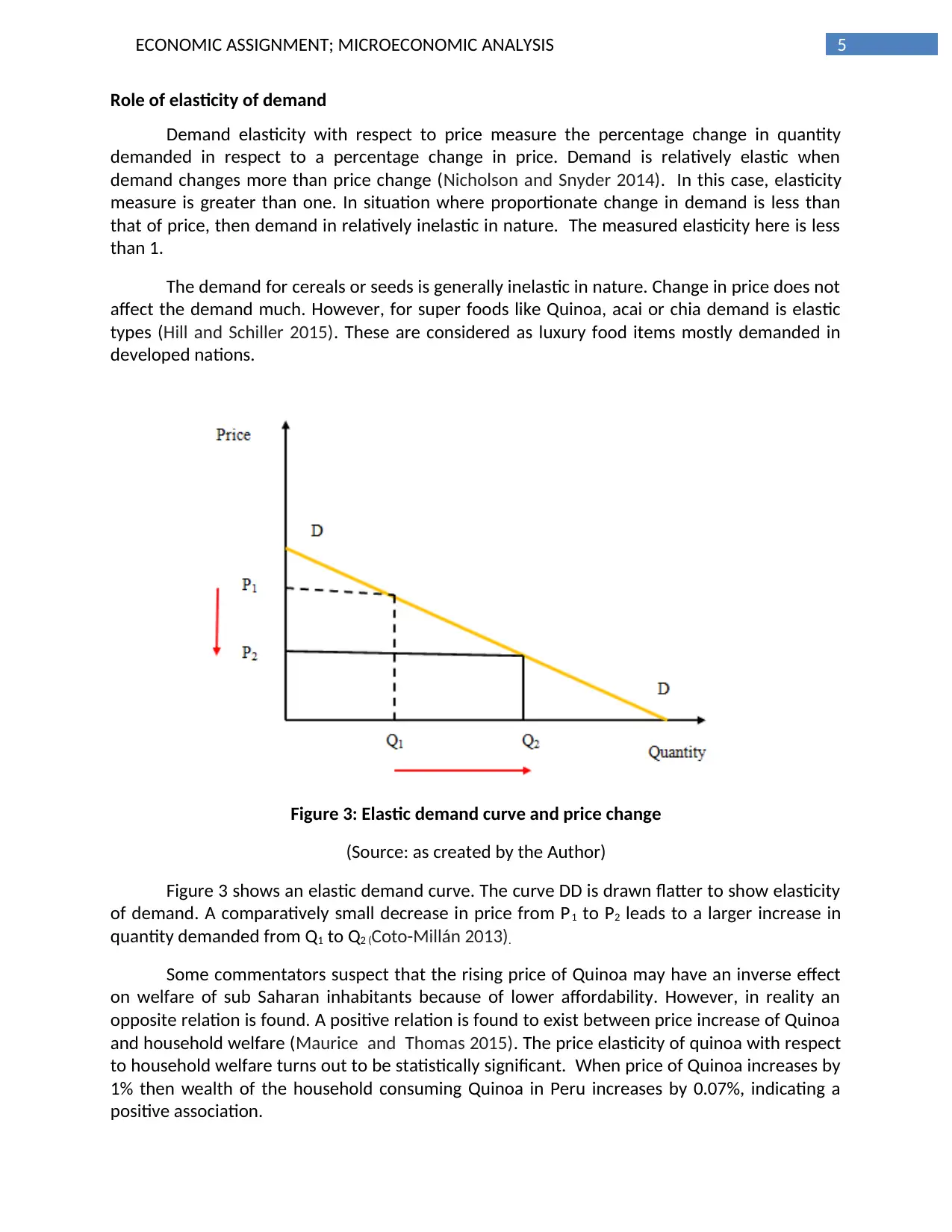
5ECONOMIC ASSIGNMENT; MICROECONOMIC ANALYSIS
Role of elasticity of demand
Demand elasticity with respect to price measure the percentage change in quantity
demanded in respect to a percentage change in price. Demand is relatively elastic when
demand changes more than price change (Nicholson and Snyder 2014). In this case, elasticity
measure is greater than one. In situation where proportionate change in demand is less than
that of price, then demand in relatively inelastic in nature. The measured elasticity here is less
than 1.
The demand for cereals or seeds is generally inelastic in nature. Change in price does not
affect the demand much. However, for super foods like Quinoa, acai or chia demand is elastic
types (Hill and Schiller 2015). These are considered as luxury food items mostly demanded in
developed nations.
Figure 3: Elastic demand curve and price change
(Source: as created by the Author)
Figure 3 shows an elastic demand curve. The curve DD is drawn flatter to show elasticity
of demand. A comparatively small decrease in price from P1 to P2 leads to a larger increase in
quantity demanded from Q1 to Q2 (Coto-Millán 2013).
Some commentators suspect that the rising price of Quinoa may have an inverse effect
on welfare of sub Saharan inhabitants because of lower affordability. However, in reality an
opposite relation is found. A positive relation is found to exist between price increase of Quinoa
and household welfare (Maurice and Thomas 2015). The price elasticity of quinoa with respect
to household welfare turns out to be statistically significant. When price of Quinoa increases by
1% then wealth of the household consuming Quinoa in Peru increases by 0.07%, indicating a
positive association.
Role of elasticity of demand
Demand elasticity with respect to price measure the percentage change in quantity
demanded in respect to a percentage change in price. Demand is relatively elastic when
demand changes more than price change (Nicholson and Snyder 2014). In this case, elasticity
measure is greater than one. In situation where proportionate change in demand is less than
that of price, then demand in relatively inelastic in nature. The measured elasticity here is less
than 1.
The demand for cereals or seeds is generally inelastic in nature. Change in price does not
affect the demand much. However, for super foods like Quinoa, acai or chia demand is elastic
types (Hill and Schiller 2015). These are considered as luxury food items mostly demanded in
developed nations.
Figure 3: Elastic demand curve and price change
(Source: as created by the Author)
Figure 3 shows an elastic demand curve. The curve DD is drawn flatter to show elasticity
of demand. A comparatively small decrease in price from P1 to P2 leads to a larger increase in
quantity demanded from Q1 to Q2 (Coto-Millán 2013).
Some commentators suspect that the rising price of Quinoa may have an inverse effect
on welfare of sub Saharan inhabitants because of lower affordability. However, in reality an
opposite relation is found. A positive relation is found to exist between price increase of Quinoa
and household welfare (Maurice and Thomas 2015). The price elasticity of quinoa with respect
to household welfare turns out to be statistically significant. When price of Quinoa increases by
1% then wealth of the household consuming Quinoa in Peru increases by 0.07%, indicating a
positive association.
⊘ This is a preview!⊘
Do you want full access?
Subscribe today to unlock all pages.

Trusted by 1+ million students worldwide
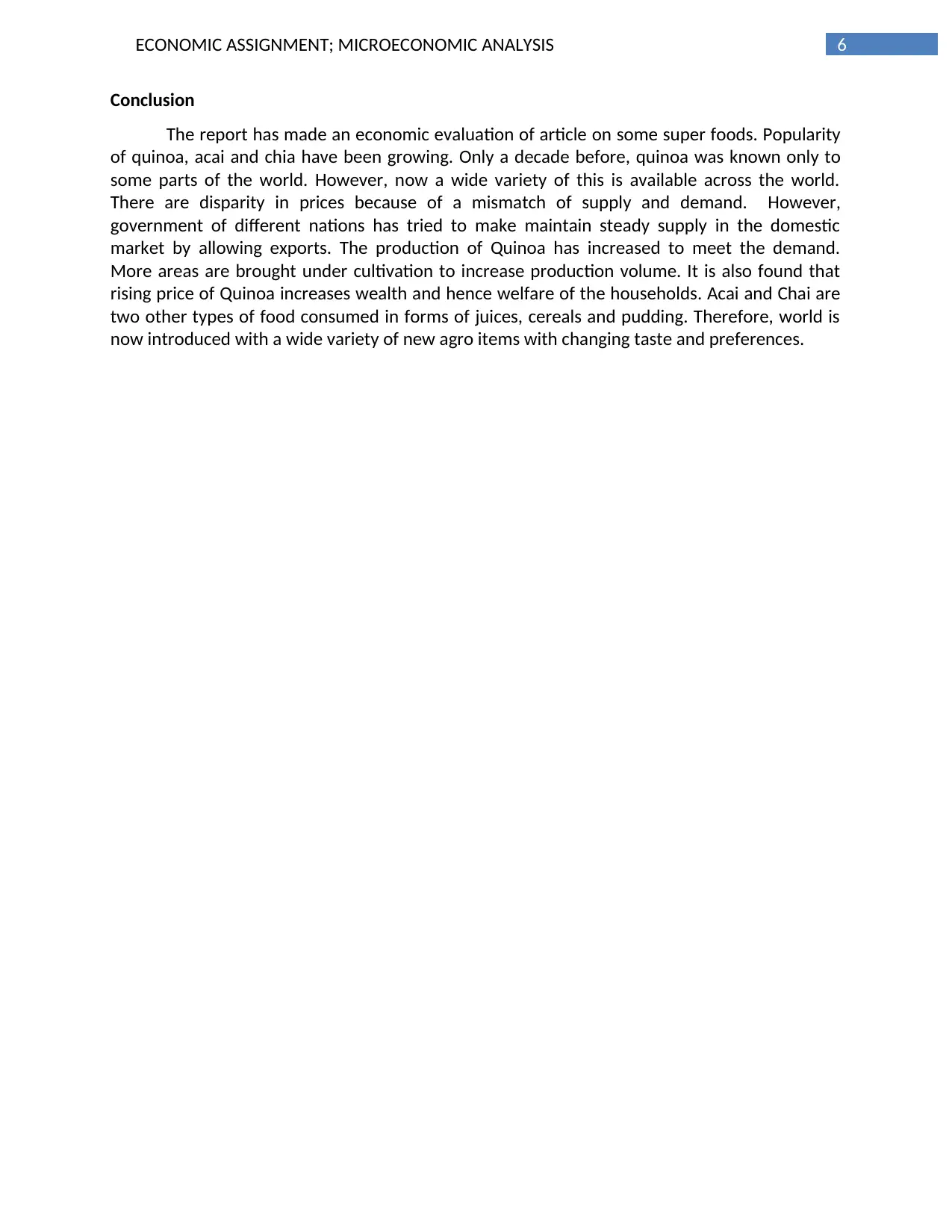
6ECONOMIC ASSIGNMENT; MICROECONOMIC ANALYSIS
Conclusion
The report has made an economic evaluation of article on some super foods. Popularity
of quinoa, acai and chia have been growing. Only a decade before, quinoa was known only to
some parts of the world. However, now a wide variety of this is available across the world.
There are disparity in prices because of a mismatch of supply and demand. However,
government of different nations has tried to make maintain steady supply in the domestic
market by allowing exports. The production of Quinoa has increased to meet the demand.
More areas are brought under cultivation to increase production volume. It is also found that
rising price of Quinoa increases wealth and hence welfare of the households. Acai and Chai are
two other types of food consumed in forms of juices, cereals and pudding. Therefore, world is
now introduced with a wide variety of new agro items with changing taste and preferences.
Conclusion
The report has made an economic evaluation of article on some super foods. Popularity
of quinoa, acai and chia have been growing. Only a decade before, quinoa was known only to
some parts of the world. However, now a wide variety of this is available across the world.
There are disparity in prices because of a mismatch of supply and demand. However,
government of different nations has tried to make maintain steady supply in the domestic
market by allowing exports. The production of Quinoa has increased to meet the demand.
More areas are brought under cultivation to increase production volume. It is also found that
rising price of Quinoa increases wealth and hence welfare of the households. Acai and Chai are
two other types of food consumed in forms of juices, cereals and pudding. Therefore, world is
now introduced with a wide variety of new agro items with changing taste and preferences.
Paraphrase This Document
Need a fresh take? Get an instant paraphrase of this document with our AI Paraphraser
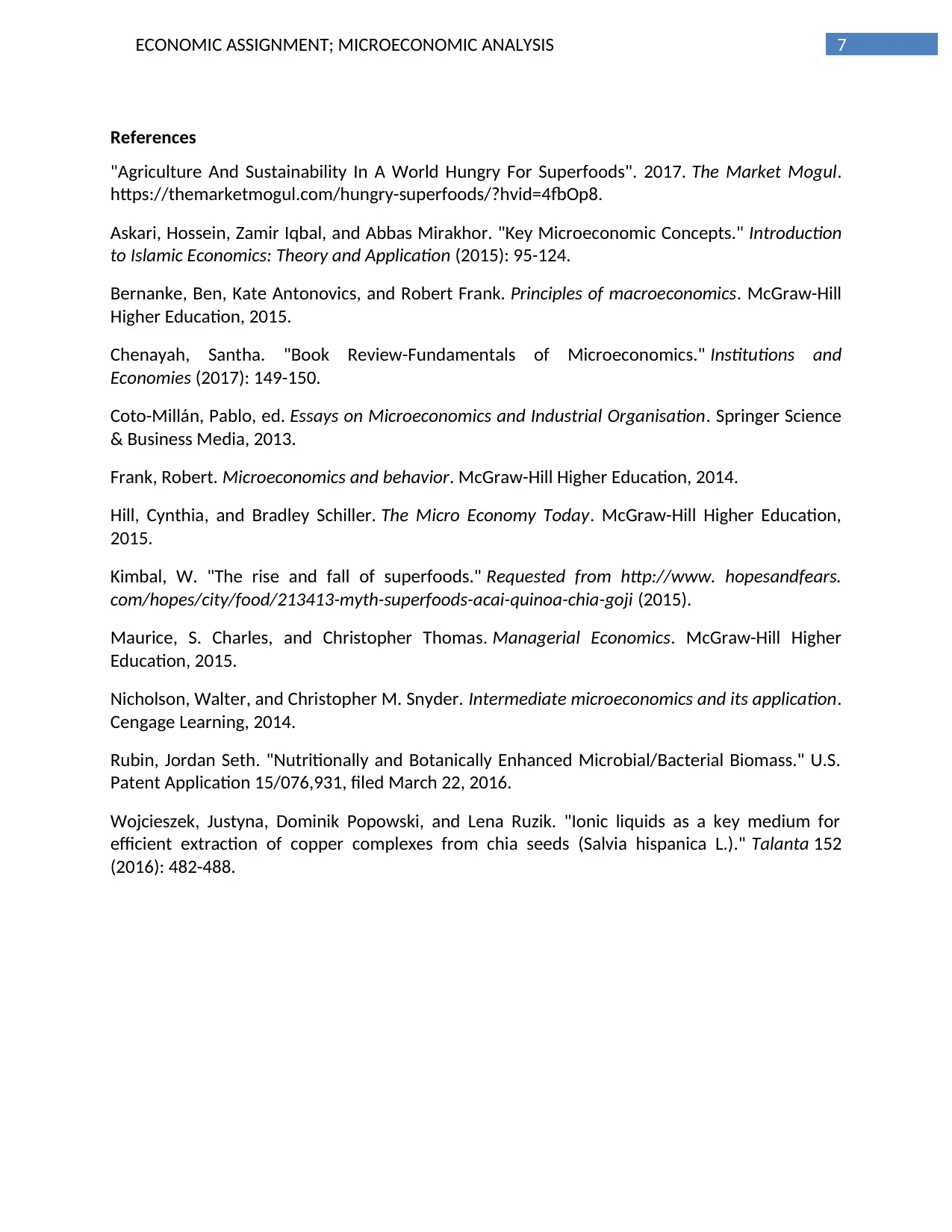
7ECONOMIC ASSIGNMENT; MICROECONOMIC ANALYSIS
References
"Agriculture And Sustainability In A World Hungry For Superfoods". 2017. The Market Mogul.
https://themarketmogul.com/hungry-superfoods/?hvid=4fbOp8.
Askari, Hossein, Zamir Iqbal, and Abbas Mirakhor. "Key Microeconomic Concepts." Introduction
to Islamic Economics: Theory and Application (2015): 95-124.
Bernanke, Ben, Kate Antonovics, and Robert Frank. Principles of macroeconomics. McGraw-Hill
Higher Education, 2015.
Chenayah, Santha. "Book Review-Fundamentals of Microeconomics." Institutions and
Economies (2017): 149-150.
Coto-Millán, Pablo, ed. Essays on Microeconomics and Industrial Organisation. Springer Science
& Business Media, 2013.
Frank, Robert. Microeconomics and behavior. McGraw-Hill Higher Education, 2014.
Hill, Cynthia, and Bradley Schiller. The Micro Economy Today. McGraw-Hill Higher Education,
2015.
Kimbal, W. "The rise and fall of superfoods." Requested from http://www. hopesandfears.
com/hopes/city/food/213413-myth-superfoods-acai-quinoa-chia-goji (2015).
Maurice, S. Charles, and Christopher Thomas. Managerial Economics. McGraw-Hill Higher
Education, 2015.
Nicholson, Walter, and Christopher M. Snyder. Intermediate microeconomics and its application.
Cengage Learning, 2014.
Rubin, Jordan Seth. "Nutritionally and Botanically Enhanced Microbial/Bacterial Biomass." U.S.
Patent Application 15/076,931, filed March 22, 2016.
Wojcieszek, Justyna, Dominik Popowski, and Lena Ruzik. "Ionic liquids as a key medium for
efficient extraction of copper complexes from chia seeds (Salvia hispanica L.)." Talanta 152
(2016): 482-488.
References
"Agriculture And Sustainability In A World Hungry For Superfoods". 2017. The Market Mogul.
https://themarketmogul.com/hungry-superfoods/?hvid=4fbOp8.
Askari, Hossein, Zamir Iqbal, and Abbas Mirakhor. "Key Microeconomic Concepts." Introduction
to Islamic Economics: Theory and Application (2015): 95-124.
Bernanke, Ben, Kate Antonovics, and Robert Frank. Principles of macroeconomics. McGraw-Hill
Higher Education, 2015.
Chenayah, Santha. "Book Review-Fundamentals of Microeconomics." Institutions and
Economies (2017): 149-150.
Coto-Millán, Pablo, ed. Essays on Microeconomics and Industrial Organisation. Springer Science
& Business Media, 2013.
Frank, Robert. Microeconomics and behavior. McGraw-Hill Higher Education, 2014.
Hill, Cynthia, and Bradley Schiller. The Micro Economy Today. McGraw-Hill Higher Education,
2015.
Kimbal, W. "The rise and fall of superfoods." Requested from http://www. hopesandfears.
com/hopes/city/food/213413-myth-superfoods-acai-quinoa-chia-goji (2015).
Maurice, S. Charles, and Christopher Thomas. Managerial Economics. McGraw-Hill Higher
Education, 2015.
Nicholson, Walter, and Christopher M. Snyder. Intermediate microeconomics and its application.
Cengage Learning, 2014.
Rubin, Jordan Seth. "Nutritionally and Botanically Enhanced Microbial/Bacterial Biomass." U.S.
Patent Application 15/076,931, filed March 22, 2016.
Wojcieszek, Justyna, Dominik Popowski, and Lena Ruzik. "Ionic liquids as a key medium for
efficient extraction of copper complexes from chia seeds (Salvia hispanica L.)." Talanta 152
(2016): 482-488.
1 out of 8
Your All-in-One AI-Powered Toolkit for Academic Success.
+13062052269
info@desklib.com
Available 24*7 on WhatsApp / Email
![[object Object]](/_next/static/media/star-bottom.7253800d.svg)
Unlock your academic potential
Copyright © 2020–2025 A2Z Services. All Rights Reserved. Developed and managed by ZUCOL.


